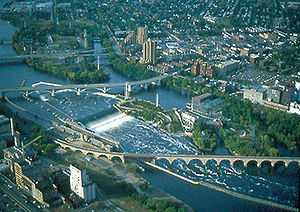Saint Anthony Falls Laboratory

The Saint Anthony Falls Laboratory (former name: Saint Anthony Falls Hydraulic Laboratory) is a research laboratory situated on Hennepin Island in the Mississippi River in Minneapolis, Minnesota, USA. Its primary research is in "Engineering, Environmental, Biological, and Geophysical Fluid Mechanics".[1] It is affiliated with the University of Minnesota.
The laboratory is unique in that its location next to Saint Anthony Falls allows it to use the hydraulic head from the waterfall to provide water for many of the experiments.
The experiments performed at the laboratory are varied, and include:
- Contract civil and environmental engineering work, such as dam construction and removal
- Understanding river system dynamics
- Work with oil exploration to characterize deposits in deltaic systems
- Work to understand the interactions between fluid flow and the ecology of rivers
- Work to understand cavitation in fluids in order to build better propellers
The Saint Anthony Falls Laboratory is also the headquarters of the National Center for Earth-surface Dynamics, a National Science Foundation Science and Technology Center.[2]
Research programs
Research at SAFL includes the work of many fields, including civil engineering, hydraulic engineering, hydrology, ecology, and geology. Research at SAFL has been spurred on in the first decade of the 21st century by its status as the headquarters of the National Center for Earth-surface Dynamics (NCED). Facilities at SAFL include the main channel, through which Mississippi River water can be sent for large-scale sediment transport experiments; the delta basins, designed to quickly build experimental stratigraphy; the eXperimental EarthScape facility (XES, nicknamed "Jurassic Tank"), a subsiding basin for large-scale depositional modeling; the Outdoor Stream Lab, which is used to understand fluvial processes and riparian ecology at closer to a field scale; and many other pieces of equipment. The lab is known for rapidly constructing and destructing experimental apparatuses, including full-scale models of rivers to understand the effects of dam removal.
Analog material models of fluvial and depositional systems are employed by geologists at SAFL to understand the causes of river channel morphologies and dynamics, as well as to reconstruct the history of events that produces particular stratigraphic packages. Researchers working on channel morphology have shown the importance of vegetation in restricting braided channels to a single thread (and often sinuous) system.[3][4] Research done on experimental alluvial fan deltas has highlighted the statistics of flow occupation and their potential hazard to life and property,[5] shown autogenic cyclicity in patterns of sediment storage and release that determine short-term shoreline positions,[6] and has been connected to sequence stratigraphy and the processes that form the stratigraphic record.[6][7][8][9][10][11]
References
- ↑ Official Website - Homepage: http://www.safl.umn.edu/
- ↑ "Welcome to NCED!". Retrieved 2009-08-15.
- ↑ Tal, Michal; Paola, Chris (2007). "Dynamic single-thread channels maintained by the interaction of flow and vegetation". Geology 35 (4): 347. Bibcode:2007Geo....35..347T. doi:10.1130/G23260A.1.
- ↑ Tal, Michal; Paola, Chris (2010). "Effects of vegetation on channel morphodynamics: results and insights from laboratory experiments". Earth Surface Processes and Landforms 35 (9): 1014. Bibcode:2010ESPL...35.1014T. doi:10.1002/esp.1908.
- ↑ Cazanacli, Dan; Paola, Chris; Parker, Gary (2002). "Experimental Steep, Braided Flow: Application to Flooding Risk on Fans". Journal of Hydraulic Engineering 128 (3): 322. doi:10.1061/(ASCE)0733-9429(2002)128:3(322).
- ↑ 6.0 6.1 Kim, Wonsuck; Paola, Chris; Swenson, John B.; Voller, Vaughan R. (2006). "Shoreline response to autogenic processes of sediment storage and release in the fluvial system". Journal of Geophysical Research 111. Bibcode:2006JGRF..11104013K. doi:10.1029/2006JF000470.
- ↑ Martin, John; Paola, Chris; Abreu, Vitor; Neal, Jack; Sheets, Ben (2009). "Sequence stratigraphy of experimental strata under known conditions of differential subsidence and variable base level". AAPG Bulletin 93 (4): 503. doi:10.1306/12110808057.
- ↑ Paul L. Heller,1 Chris Paola,2 In-G (2001). "Geomorphology and sequence stratigraphy due to slow and rapid base-level changes in an experimental subsiding basin (XES 96-1)". AAPG Bulletin 85. doi:10.1306/8626CA0F-173B-11D7-8645000102C1865D.
- ↑ Sheets, B. A.; Hickson, T. A.; Paola, C. (2002). "Assembling the stratigraphic record: depositional patterns and time-scales in an experimental alluvial basin". Basin Research 14 (3): 287. doi:10.1046/j.1365-2117.2002.00185.x.
- ↑ Kim, Wonsuck; Paola, Chris (2007). "Long-period cyclic sedimentation with constant tectonic forcing in an experimental relay ramp". Geology 35 (4): 331. Bibcode:2007Geo....35..331K. doi:10.1130/G23194A.1.
- ↑ Strong, N.; Paola, C. (2008). "Valleys That Never Were: Time Surfaces Versus Stratigraphic Surfaces". Journal of Sedimentary Research 78 (8): 579. Bibcode:2008JSedR..78..579S. doi:10.2110/jsr.2008.059.